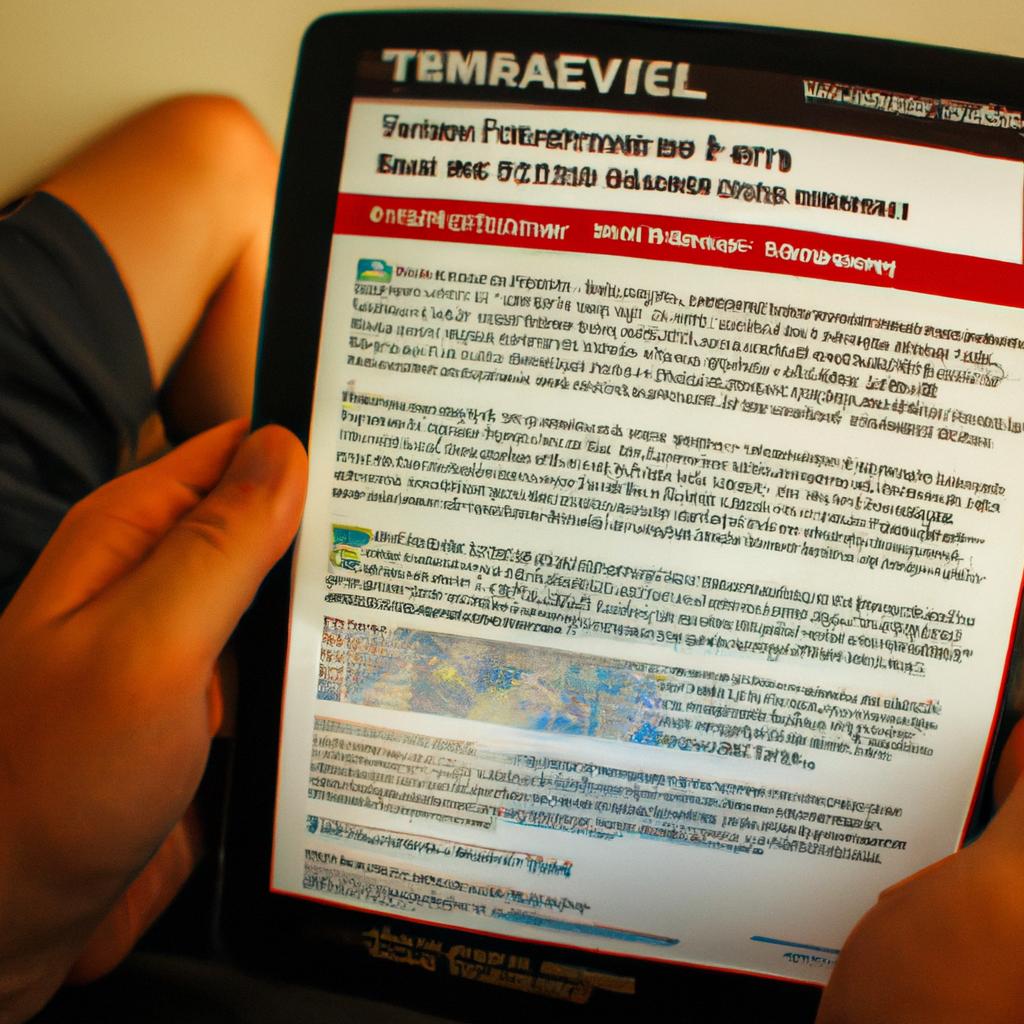Hiking, a popular recreational activity that combines physical exercise with the exploration of natural landscapes, has become increasingly affected by travel politics and global events. In recent years, hikers have encountered various challenges such as navigating through regions marked by political unrest or facing unexpected obstacles due to changes in government policies. For instance, imagine a group of adventurous backpackers planning a trek through a remote mountain range only to discover that their desired route crosses an area where tensions between neighboring countries are escalating. Such scenarios highlight the importance of staying informed about travel advisories and understanding how geopolitical dynamics impact hiking experiences.
Travel politics play a significant role in shaping the accessibility and safety of hiking destinations worldwide. Governments issue travel advisories to inform citizens of potential risks associated with specific locations based on factors like political instability, terrorism threats, health concerns, or natural disasters. These advisories serve as crucial tools for travelers as they provide valuable information regarding the current state of affairs in different parts of the world. By examining these advisories, individuals can make informed decisions about where to hike and take appropriate precautions when necessary. Additionally, being aware of travel politics allows hikers to understand the broader context in which their outdoor activities unfold and appreciate the interconnectedness between global events and personal adventures.
Understanding Hiking Safety
Imagine this scenario: Sarah, an adventurous hiker, embarks on a solo hiking trip in the rugged mountains of New Zealand. She carefully plans her route and packs essential supplies for her journey. However, halfway through her expedition, she encounters treacherous weather conditions that force her to take shelter. In this situation, understanding hiking safety becomes paramount.
To ensure a safe hiking experience, it is crucial to be aware of potential hazards and take necessary precautions. One must consider factors such as terrain difficulty, weather patterns, wildlife encounters, and navigation skills. The following bullet points highlight some key aspects of hiking safety:
- Familiarize yourself with trail ratings and difficulty levels.
- Check weather forecasts before setting out on your hike.
- Carry appropriate gear including sturdy footwear, adequate clothing layers, and ample food and water supplies.
- Develop basic map reading and compass skills or utilize GPS devices for navigation.
Moreover, comprehending the significance of these safety measures can be further aided by visual aids like tables. Here’s an example showcasing different types of hiking trails along with their corresponding difficulty levels:
| Trail Type | Difficulty Level |
|---|---|
| Easy | Beginner |
| Moderate | Intermediate |
| Challenging | Advanced |
| Strenuous | Expert |
By referring to this table, hikers can gauge the level of preparedness required for each type of trail they plan to undertake. This information not only assists in selecting suitable hikes but also helps manage expectations regarding physical exertion and potential risks involved.
In summary, embracing hiking safety involves recognizing potential dangers while exploring nature’s wonders. By considering various factors such as terrain difficulty and weather conditions before venturing into unfamiliar territories, hikers can minimize risks associated with outdoor adventures effectively. With an understanding of these principles established, let us now delve into the process of choosing the right hiking trail—a critical step in ensuring a safe and enjoyable journey.
Choosing the Right Hiking Trail
Hiking: Travel Politics News: Travel Advisories
Understanding Hiking Safety
Imagine this scenario: You are an avid hiker planning a trip to the beautiful mountains of Colorado. As you eagerly research hiking trails and prepare your gear, it is crucial to be aware of potential travel advisories that might affect your plans. In recent years, there has been a growing intersection between politics and travel, resulting in the issuance of various advisories for certain destinations. Understanding these advisories can help ensure your safety while enjoying the great outdoors.
Travel advisories provide valuable information about potential risks or dangers associated with specific regions or countries. These advisories are typically issued by governments or international organizations to inform travelers about security concerns, natural disasters, civil unrest, health hazards, or other significant events that may impact their safety. Being knowledgeable about such advisory warnings before embarking on a hiking adventure allows you to make informed decisions regarding your destination selection and itinerary planning.
To better comprehend the significance of travel advisories concerning hiking safety, consider the following key points:
- Awareness: Staying updated on current travel advisories helps align your expectations and preparations accordingly.
- Risk Assessment: Evaluating the level of risk associated with a particular location allows you to weigh potential dangers against your personal comfort level.
- Preparation: Taking necessary precautions based on available information ensures you are adequately equipped for any challenges that may arise during your hike.
- Contingency Planning: Having alternative options in mind enables you to adapt quickly should unforeseen circumstances occur.
Here’s an example table illustrating how different levels of travel advisories can influence decision-making:
| Advisory Level | Description | Implications |
|---|---|---|
| Low | Exercise normal precautions | Minimal risk |
| Medium | Exercise increased caution | Heightened awareness |
| High | Reconsider travel | Potential danger |
| Extreme | Do not travel | Severe threat |
By understanding and considering these travel advisories, hikers can make informed choices and take appropriate measures to ensure their safety. It is essential to consult official government websites or international organizations for the most up-to-date information on specific hiking destinations.
Looking ahead to the next section about “Preparing for a Hiking Trip,” it is important to note that being aware of travel advisories is just one aspect of ensuring a safe and enjoyable hiking experience.
Preparing for a Hiking Trip
Having considered how to choose the right hiking trail, it is equally important to be adequately prepared before embarking on your adventure. By taking necessary precautions and ensuring you have everything you need, you can make the most of your hiking experience.
To illustrate the significance of proper preparation, let’s consider an example where inadequate planning had adverse consequences. Imagine Jane, an enthusiastic hiker who decided to undertake an ambitious multiday hike without thoroughly researching her route or checking weather forecasts. As a result, she encountered unexpected severe weather conditions that left her stranded with insufficient supplies. This scenario emphasizes the importance of thorough preparation in order to mitigate potential risks and ensure a safe and enjoyable hiking trip.
In preparing for your own hiking trip, here are some key considerations:
- Researching the trail: Familiarize yourself with the chosen trail by reading guidebooks or online resources. Understand its difficulty level, length, elevation gain/loss, and any specific challenges that may arise.
- Packing essentials: Create a comprehensive checklist of essential items such as appropriate clothing layers, sturdy footwear, navigation tools (maps or GPS), extra food and water provisions, first aid kit, emergency shelter (tent or bivvy sack), headlamp or flashlight with extra batteries.
- Checking weather conditions: Stay updated with current weather forecasts for both the starting point and destination of your hike. Be flexible enough to adjust plans accordingly if unfavorable conditions are predicted.
- Informing others about your plans: Share your itinerary with someone reliable who can monitor your progress remotely. Provide them with estimated start and end times so they can alert authorities if needed.
| Key Considerations | Importance |
|---|---|
| Researching the trail | High |
| Packing essentials | Very high |
| Checking weather conditions | Moderate |
| Informing others about your plans | High |
- Adequate preparation ensures a safe and enjoyable hiking experience.
- Being knowledgeable about the chosen trail reduces the chances of getting lost or encountering unexpected challenges.
- Proper packing helps in staying comfortable, well-nourished, and prepared for emergencies.
- Staying informed about weather conditions allows you to make informed decisions and avoid hazardous situations.
In summary, proper preparation is crucial before embarking on any hiking trip. By researching the trail, packing essential items, checking weather conditions, and informing others about your plans, you can increase safety while maximizing enjoyment. In the subsequent section regarding “Navigating Hiking Regulations,” we will explore how to navigate various regulations that may be encountered during your hike.
Navigating Hiking Regulations
Imagine planning a hiking trip to an exotic location, where breathtaking landscapes await you. You have researched the best trails, packed your gear, and are ready to embark on this adventure. However, before setting foot on those pristine paths, it is crucial to familiarize yourself with hiking regulations and travel advisories that may impact your journey.
Understanding these regulations ensures not only your safety but also the preservation of natural habitats and ecosystems. For instance, let’s consider the case study of Mount Everest Base Camp in Nepal. Due to increasing environmental concerns and overcrowding issues, the Nepalese government has implemented new rules for climbers intending to summit the world’s highest peak. These guidelines include limiting permits issued each season and enforcing strict waste management practices at higher altitudes.
To shed light on different aspects of hiking regulations and travel advisories, here are some key points to keep in mind:
- Trail Permits: Many popular hiking destinations require obtaining trail permits or passes before embarking on a hike. These permits serve multiple purposes such as funding conservation efforts, managing visitor numbers, and ensuring hikers’ safety.
- Leave No Trace Principles: Emphasizing minimal ecological impact while trekking through wilderness areas is vital for preserving delicate ecosystems. The principles of leaving no trace involve minimizing campfire impacts, disposing waste properly, respecting wildlife habitats, staying on designated trails, and avoiding damage to vegetation.
- Wildlife Protection Measures: In certain regions known for their rich biodiversity or endangered species populations, specific guidelines might be in place to safeguard wildlife from human interference. This could include restrictions on noise levels or prohibiting interaction with animals.
- Weather Warnings: Checking weather forecasts and heeding warnings issued by local authorities is essential before venturing into unfamiliar terrains. Extreme weather conditions can pose significant risks during hikes; being well-informed helps minimize potential hazards.
Table: Common Hiking Regulations
| Regulation | Purpose |
|---|---|
| Trail permits | Funding conservation efforts, managing visitor numbers, ensuring safety |
| Leave No Trace principles | Minimizing ecological impact, preserving delicate ecosystems |
| Wildlife protection measures | Safeguarding biodiversity and endangered species populations |
| Weather warnings | Mitigating risks associated with extreme weather conditions |
By adhering to these regulations and staying informed about travel advisories, you can contribute to sustainable hiking practices while also safeguarding your own well-being. Remember that responsible hikers have a profound impact not only on their personal experience but also on the overall preservation of natural wonders.
As we delve into understanding proper hiking etiquette in our next section, let’s explore how respecting nature and fellow hikers adds value to this incredible outdoor activity.
Hiking Etiquette: Respecting Nature and Other Hikers
H2 Transition: Having discussed the various regulations that hikers must navigate, it is also important to consider the travel advisories associated with hiking destinations. These advisories provide valuable information regarding potential risks and concerns that travelers should be aware of before embarking on their hiking adventures.
To illustrate the significance of travel advisories in relation to hiking, let us consider a hypothetical scenario. Imagine a group of hikers planning an expedition to a remote mountain range known for its challenging trails and breathtaking views. Prior to their departure, they consult the travel advisory issued by their national government. The advisory highlights recent incidents of wildlife encounters resulting in injuries as well as reports of treacherous weather conditions in the area. Armed with this crucial information, the hikers can now make informed decisions about whether or not to proceed with their planned adventure.
- Wildlife encounters have been reported, posing a risk to hiker safety.
- Adverse weather conditions may arise unexpectedly, increasing the difficulty level of trails.
- Limited emergency services are available in case of accidents or emergencies.
- Local authorities recommend carrying necessary survival equipment due to remoteness and unpredictable nature of some areas.
Table: Potential Risks Highlighted in Travel Advisory
| Risk | Description |
|---|---|
| Wildlife encounters | Increased likelihood of encountering potentially dangerous animals |
| Adverse weather conditions | Unpredictable changes in weather patterns that could lead to hazardous situations |
| Limited emergency services | Scarce availability of immediate medical assistance or rescue teams |
| Recommended gear | Essential items advised for carrying during hikes such as first aid kits and navigation tools |
Paragraph 1:
The presence of travel advisories serves as a reminder that while hiking can offer exhilarating experiences amidst stunning natural landscapes, it is essential for individuals to remain mindful of potential risks and challenges. Such advisories aim to ensure the safety of hikers, providing them with valuable insights into specific concerns they may encounter during their journey.
Paragraph 2:
In our hypothetical scenario, the travel advisory highlights wildlife encounters as a significant risk. This information prompts the hikers to research further on ways to mitigate such encounters, such as carrying bear spray or understanding animal behavior. Additionally, being aware of potential weather changes allows them to pack appropriate gear like raincoats or warm clothing for unexpected climate shifts. Moreover, knowledge about limited emergency services enables the group to plan meticulously and be prepared for any unforeseen circumstances that may arise.
Paragraph 3:
By reviewing these travel advisories before embarking on hiking expeditions, individuals can assess whether they possess the necessary skills and equipment required for each particular destination. Furthermore, travelers can make informed decisions regarding their own capabilities and readiness in tackling potential risks identified by these advisories.
Understanding how travel advisories play an integral role in promoting safe hiking practices is just one aspect of ensuring enjoyable outdoor experiences.
Exploring the Benefits of Hiking
Respecting Nature and Other Hikers:
Hiking is not only a great way to connect with nature, but it also provides an opportunity for individuals to interact with fellow hikers. Respecting both the environment and other hikers is essential in ensuring a positive hiking experience for everyone involved. By following proper hiking etiquette, we can foster a sense of community on the trails.
Imagine you are hiking along a picturesque trail surrounded by lush greenery when suddenly you encounter another group of hikers coming from the opposite direction. This situation presents an excellent example of how practicing good hiking etiquette can make all the difference. By stepping aside and allowing the other group to pass first, you demonstrate respect and consideration towards your fellow hikers. This simple act promotes harmony on the trails and prevents unnecessary obstructions or conflicts.
To further emphasize the importance of respecting nature and other hikers, consider these key points:
- Leave No Trace: Always remember to leave no trace behind as you hike. This means packing out any trash or waste, staying on designated trails, and avoiding damage to plants or wildlife.
- Yielding Right of Way: When encountering others on narrow paths or uphill sections, be courteous by yielding right of way. Step aside if necessary and allow faster-moving hikers or those going downhill to pass safely.
- Noise Control: Keep noise levels to a minimum during your hikes to preserve the tranquility of natural surroundings. Avoid playing loud music or engaging in disruptive conversations that may disturb wildlife or other hikers seeking peaceful solitude.
- Group Size Awareness: Be mindful of group sizes while hiking. Large groups can overwhelm trails and disrupt others’ experiences. If partaking in a larger group hike, split into smaller subgroups whenever possible.
Emphasizing these guidelines through visual representation can evoke an emotional response among readers:
| Key Points |
|---|
| Leave No Trace |
| Yielding Right of Way |
| Noise Control |
| Group Size Awareness |
In conclusion, practicing proper hiking etiquette is crucial for maintaining the beauty and harmony of nature while ensuring a positive experience for all hikers. By adhering to guidelines such as leaving no trace, yielding right of way, controlling noise levels, and being aware of group sizes, we can create an environment that promotes respect towards both nature and fellow outdoor enthusiasts. So next time you embark on a hike, remember the significance of these principles and contribute to a more enjoyable hiking community.
 Plains News
Plains News



